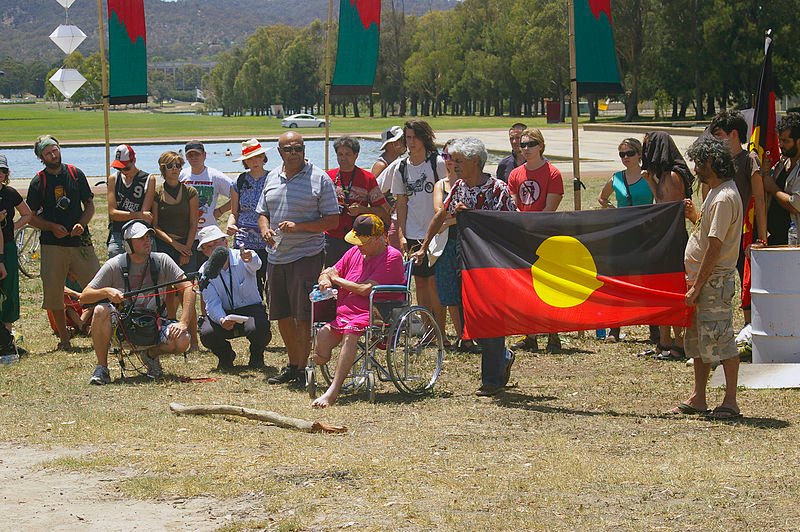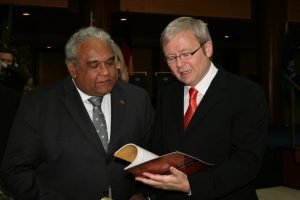Following the death of George Floyd, Black Lives Matter protests in the US have sparked a string of protests on our own shores, as the often-overlooked issue of police brutality against Indigenous Australians returns to the forefront.
On and off-campus, there are plenty of opportunities to help international students learn about the Australian way of life from English conversation groups to beach safety events — but how much do international students know about Indigenous history?

Black Lives Matter protests rage on in the United States of America demanding justice for George Floyd
Many current domestic students may be able to recall participating in an Indigenous education program at some point in their life. Former Prime Minister Kevin Rudd’s 2007 “sorry speech” was made a compulsory viewing for primary school students nationwide. The year 7-10 Aboriginal studies syllabus states that its primary focus is for students to develop “an appreciation which acknowledges and addresses racism existing in Australian society and promotes inclusiveness.”
Whether or not the emphasis on Indigenous history in primary and secondary education syllabuses is enough remains a debate, but the fact remaining is that your average domestic student could confidently name a fact about the Stolen Generation, or even recite an Aboriginal Dreamtime story.
For international students, there is no such equivalent. Western Sydney University’s Welcome guide for International students provides a brief history of European settlement, but unless they choose to take up a voluntary subject on Aboriginal culture, resources and opportunities for international students to gain an in-depth understanding of Australia’s history are scarce.
In 2015, after uncovering a lack of Indigenous literacy among its students, La Trobe University introduced a compulsory first-year module on Indigenous culture. The decision was said to not only allow domestic students to enhance their knowledge of Indigenous issues, but to also provide a chance for international students to learn and interact with Aboriginal elders. Western Sydney University could also pursue a similar policy.

Rabbit Proff Fence wonderfully depicts the stolen generation’s struggles in film. Source: Wikipedia
What do international students think?
When asked whether international students have sufficient knowledge on Indigenous culture, Anil Adhikari, a Master of Information and Communications student from India, mentioned that life was stuck between university, assignments and his part-time job.
Bangladeshi accounting student Nazmul Haque Shakil, says that most times it is uncommon to meet or even see Indigenous people. “I haven’t met a single person from that culture, and moreover its very rare seeing them around in Sydney and surrounding suburbs. So, I don’t have much idea about their culture and living standards.”

WSU is home to more than 7,000 international students. Source: pexels.com
What are their suggestions?
Nazmul said he would appreciate lessons on Indigenous culture. Anil on the other hand had suggested an opt-in mechanism. “Making international students learn won’t be helpful. It’s a good idea to make international students know the Aboriginal culture but only if the students are willing to learn. Making subjects compulsory and forcing them to pay fees for that subject or spend their valuable time is not a good idea.”
Anil also added, “The other thing they can do is make it an online video of one to two hours and ask students to make a report on it – this will be the best solution. International students can take out this much of time and they can also learn about aboriginal culture.”
Why is it important in the first place?
Despite several Federal Government initiatives to “close the gap”, including scholarships and increased funding, racism towards Aboriginal staff and students still prevails within universities. In 2018, the National Tertiary Education Union (NTEU) reported that three quarters of Aboriginal and Torres Strait Islander university staff had experienced racial discrimination in the workplace.
Education is a powerful tool to start to unlearn prejudicial attitudes, and to learn about social disparities so that we may stand together to correct them. Furthermore, in a country where Indigenous Australians make up only three per cent of the population, it becomes increasingly important to preserve Indigenous culture among future generations.
The lack of understanding about Aboriginal people is one that exists within our campuses as well and providing opportunities such as these is integral to the continuation of the culture.

Some statistics from the NTEU report
Kristy Bell, the Student Success officer at the Badanami Centre, which is WSU’s centre for Indigenous education, says that providing Indigenous education for international students is important for the longevity of our culture. “Indigenous culture is the history of Australia,” she stated in an email. “If it is not shared among all people, the Aboriginal culture will be lost.”
It’s no doubt that international students entering a new country face a vast series of challenges. From navigating transport systems to finding a job and learning to converse in English, international students have their hands full. However, we must find a way to integrate knowledge about the Indigenous people on whose land they now reside. International students can use the following avenues to enrich their understanding of Aboriginal culture.
Where can international students go to find out more about Indigenous culture?
If you’re an international student who wants to learn more about Aboriginal culture, there are plenty of opportunities both on and off-campus to get involved.
Get involved
There are a number of events across Sydney you can attend to immerse yourself in Aboriginal culture. Western Sydney hosts regular programs during NAIDOC Week (5th-12th July) including art classes and musical performances. Alternatively, you may choose to attend an Aboriginal Heritage tour or see an Aboriginal play at one of the many local theatres.
Study an Indigenous history unit
One of the many Aboriginal electives available at Western Sydney University will help form a solid introduction to Indigenous culture for those who are new. Not only are they available across a variety of disciplines, you will have your peers and tutors to guide you through any further questions you may have.

The Badanami Centre at WSU
Visit the Badanami centre
The Badanami centre is a great start for Aboriginal and Torres Strait Islander related resources. Their website has plenty of free resources including the Aboriginal Studies virtual library and links to Indigenous news articles.




